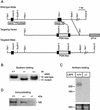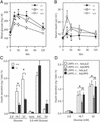Low-density lipoprotein receptor-related protein 5 (LRP5) is essential for normal cholesterol metabolism and glucose-induced insulin secretion
- PMID: 12509515
- PMCID: PMC140935
- DOI: 10.1073/pnas.0133792100
Low-density lipoprotein receptor-related protein 5 (LRP5) is essential for normal cholesterol metabolism and glucose-induced insulin secretion
Abstract
A Wnt coreceptor low-density lipoprotein receptor-related protein 5 (LRP5) plays an essential role in bone accrual and eye development. Here, we show that LRP5 is also required for normal cholesterol and glucose metabolism. The production of mice lacking LRP5 revealed that LRP5 deficiency led to increased plasma cholesterol levels in mice fed a high-fat diet, because of the decreased hepatic clearance of chylomicron remnants. In addition, when fed a normal diet, LRP5-deficient mice showed a markedly impaired glucose tolerance. The LRP5-deficient islets had a marked reduction in the levels of intracellular ATP and Ca(2+) in response to glucose, and thereby glucose-induced insulin secretion was decreased. The intracellular inositol 1,4,5-trisphosphate (IP3) production in response to glucose was also reduced in LRP5-- islets. Real-time PCR analysis revealed a marked reduction of various transcripts for genes involved in glucose sensing in LRP5-- islets. Furthermore, exposure of LRP5++ islets to Wnt-3a and Wnt-5a stimulates glucose-induced insulin secretion and this stimulation was blocked by the addition of a soluble form of Wnt receptor, secreted Frizzled-related protein-1. In contrast, LRP5-deficient islets lacked the Wnt-3a-stimulated insulin secretion. These data suggest that WntLRP5 signaling contributes to the glucose-induced insulin secretion in the islets.
Figures





References
-
- Wehrli M, Dougan S T, Caldwell K, O'Keefe L, Schwartz S, Vaizel-Ohayon D, Schejter E, Tomlinson A, DiNardo S. Nature. 2000;407:527–530. - PubMed
-
- Tamai K, Semenov M, Kato Y, Spokony R, Liu C, Katsuyama Y, Hess F, Saint-Jeannet J P, He X. Nature. 2000;407:530–535. - PubMed
-
- Pinson K I, Brennan J, Monkley S, Avery B J, Skarnes W C. Nature. 2000;407:535–538. - PubMed
-
- Bafico A, Liu G, Yaniv A, Gazit A, Aaronson S A. Nat Cell Biol. 2001;3:683–686. - PubMed
-
- Mao J, Wang J, Liu B, Pan W, Farr G H, III, Flynn C, Yuan H, Takada S, Kimelman D, Li L, Wu D. Mol Cell. 2001;7:801–809. - PubMed
Publication types
MeSH terms
Substances
LinkOut - more resources
Full Text Sources
Other Literature Sources
Medical
Molecular Biology Databases
Research Materials
Miscellaneous

